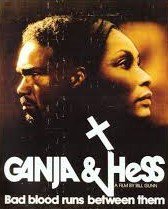Ganja and Hess
With an introduction from artist and writer John CussansDir: Bill Gunn, 1973, USA, 113 min, Cert: 18
-
Fri 5 April 2019 // 18:00
/ Cinema
Tickets: £7/5
Join us for a special screening of Bill Gunn’s stylized, experimental horror film Ganja and Hess (1973), featuring Marlene Clark and Duane Jones (best known for his starring role in Night of the Living Dead). Low-budget and independently produced, the film has often been associated with the blaxploitation films popular at the time of its release (Shaft, 1971; Super Fly, 1972; Blacula, 1972), as well as the vampire horror genre—yet Ganja and Hess deliberately and significantly subverts generic elements and expectations throughout. At its core is a love story, one which draws in and explores themes of addiction, class, Christian mysticism, and cultural imperialism. While produced on a low budget, and at times difficult to watch and follow, the film is worth the patient attention it requires to appreciate its unusual and creative take on the vampire myth, as well as its place within the pantheon of independent African American cinema.
Dr. Hess Green, an independently wealthy anthropologist who lives on a remote estate, specializes in the study of an ancient African culture known for incorporating the drinking of blood into ritual practices. When his assistant George (played by Gunn) stabs him with a ceremonial dagger, Hess gains both immortality and an insatiable need for blood. George subsequently commits suicide, and his wife Ganja arrives in search of him. Instead she embarks on a passionate love affair with Hess—one which will set both their lives on a new course.
While previous editions of the film were significantly cut, this screening will present the original release, restored by the Museum of Modern Art with support from the Film Foundation, and mastered in HD from a 35mm negative.
The film will be introduced by John Cussans, author of Undead Uprising: Haiti, Horror and the Zombie Complex (MIT/Strange Attractor 2017), which has been described by LeGrace Benson, President of the Haitian Studies Association, as “a must read for anyone wishing to understand more about the destinies of African-based religions in the Americas”.

